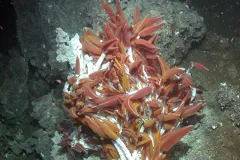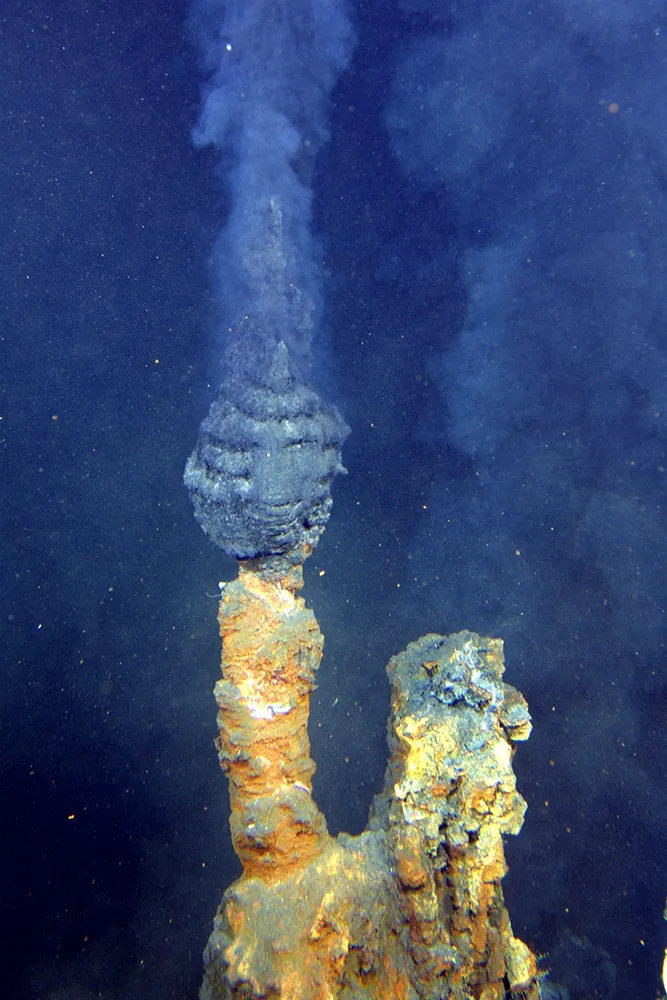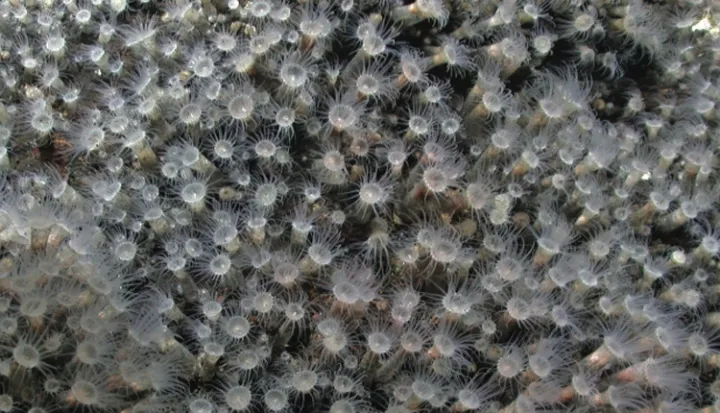The Microbes That Keep Hydrothermal Vents Pumping

Life is typically sparse on the deep seafloor, where organisms endure high pressure, near-freezing temperatures and pitch-black darkness. But at certain spots on the ocean floor where tectonic plates meet, unique ecosystems teem with unusual animal species. There, mineral-laden fluid is emitted either as a warm (5-100 degrees Celsius/41-212 degrees Fahrenheit), diffuse flow from seabed cracks or as plumes of superheated water (250-400 degrees Celsius/482-752 degrees Fahrenheit) from chimney-like structures. These structures are referred to as hydrothermal vents, and the assortment of animals surrounding them are referred to as hydrothermal vent communities. When first discovered in the 1970s, these oases in the deep sea were a complete surprise—Dr. Bob Ballard calls them a far more important discovery than his finding of the wreck of the Titanic!
The animals are spectacular, but often overlooked are the organisms that make these ecosystems possible: the microbes that convert the mineral-laden fluid into energy.
Most bacteria and archaea cannot survive in the superheated hydrothermal fluids of the chimneys or “black smokers.” But hydrothermal microorganisms are able to thrive just outside the hottest waters, in the temperature gradients that form between the hot venting fluid and cold seawater. These microbes are the foundation for life in hydrothermal vent ecosystems. Instead of using light energy to turn carbon dioxide into sugar like plants do, they harvest chemical energy from the minerals and chemical compounds that spew from the vents—a process known as chemosynthesis. These compounds—such as hydrogen sulfide, hydrogen gas, ferrous iron and ammonia—lack carbon. The microbes release new compounds after chemosynthesis, some of which are toxic, but others can be taken in nutritionally by other organisms.
Chemical-harvesting microorganisms are found in different habitats all over the world, and they are essential to the hydrothermal vent ecosystem. Like plants and algae on land and in shallow waters, the vent microbes are the primary producers in their food web and are eaten by larger animals. Bottom feeders like limpets graze on microbial mats up to three centimeters thick, and suspension feeders like mussels feed on bacteria floating in the water. Other animals, like the Yeti crab, feed on microbes that grow on their surfaces. Some bacteria live as symbiotic partners in the tissues of larger host organisms, like the giant gutless vent tube worms, which are fed by the microbes in exchange for providing them with shelter.
Let's meet some of the microbes that make this amazing ecosystem possible.
Methanopyrus kandleri is a heat- and salt-loving species of Archaea that makes its home on the chimney walls of smokers. It harvests energy from hydrogen gas and releases methane, a process known as methanogenesis. It's this process that gives the microbe its name: Methanopyrus translates to “methane fire.” Methanopyrus kandleri has been isolated from hydrothermal sediments at Kolbeinsey Ridge off the coast of Iceland and the Guaymas Basin in the Gulf of California. In the laboratory its cells can even divide at 122°C, the highest temperature known to be compatible with microbial growth, though it grows best at 98°C.
Scientists isolated species of Pyrolobus (“fire lobe”) and Pyrodictium (“fire network”) Archaea also from chimney walls. These heat-loving microbes (which grow optimally at temperatures above 100°C) get their energy from hydrogen gas and produce hydrogen sulfide from sulfur compounds from the vents. Hydrogen sulfide is highly toxic to most animals, including people. However, animals at hydrothermal vents have special biochemical adaptations that protect them from hydrogen sulfide.
One of these hydrogen sulfide-making species is Pyrolobus fumarii (or "fire lobe of the chimney"), that was first isolated from a hydrothermal vent at the Mid-Atlantic Ridge. It grows at 90-113°C and has an optimal temperature of 106°C. Pyrodictium abyssi are disc-shaped cells that grow attached to networks of hollow tubes that resemble tree roots. These microbes grow best at 105C but can reproduce between 80 and 110°C.
Green sulfur bacteria are unique among hydrothermal vent bacteria because they require both chemical energy (from hydrogen sulfide) and light energy to survive. Green sulfur bacteria contain chlorosomes, organelles that are so efficient at harvesting light that green sulfur bacteria can grow at much lower light intensities than other light-requiring microbes. There is no sunlight at hydrothermal vents, and instead they capture energy from the weak radioactive glow emitted from geothermally heated rock.
We still have much to learn about these and other “extremophiles” (lovers of extreme conditions, at least from a human perspective). Extremophiles might have been among the earliest life forms on earth and have possible uses in industry. It’s possible that someday we may find extremophiles living on other planets.
Editor's note: This article was written by student Lyndsy Gazda and the Smithsonian Ocean team.




